publications
2024
-
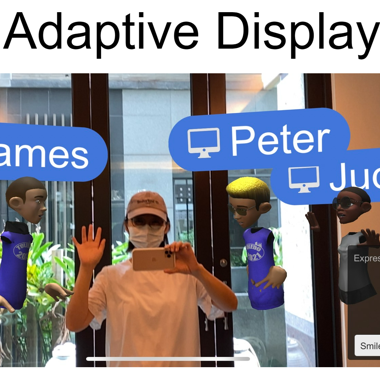 AFTER: Adaptive Friend Discovery for Temporal-spatial and Social-aware XRBing-Jyue Chen, Chiok Yew Ho, and De-Nian YangIn IEEE International Conference on Data Engineering (IEEE ICDE) May 2024
AFTER: Adaptive Friend Discovery for Temporal-spatial and Social-aware XRBing-Jyue Chen, Chiok Yew Ho, and De-Nian YangIn IEEE International Conference on Data Engineering (IEEE ICDE) May 2024Recent advancements in the field of extended reality (XR) have garnered significant interest in XR socialization. However, traditional social XR experiences often fall short of satisfying users’ social expectations due to the negligence of the emerging opportunities in XR. In this paper, we propose a novel scenario of socializing in social XR, which has the potential to substantially enhance traditional social media through i) the recommendation of appropriate surrounding users that cater to users’ individual preferences, ii) the adaptive avoidance of view occlusions to facilitate users in locating their friends, iii) the consideration of users’ social presence, and iv) the development of cross-platform solutions to provide hybrid participation. To this end, we formulate Adaptive Friend Discovery for Temporal-spatial and Social-aware XR, a new NP-hard social recommendation problem aiming at satisfying social XR users. The proposed model, POSHGNN, is a deep temporal graph learning framework designed to provide efficient social recommendations for target users. Experimental results obtained from real-world social XR datasets and a user study that supports multiple XR interfaces demonstrate that the proposed method outperforms baseline approaches with an improvement of 18.5% in solution quality.
-
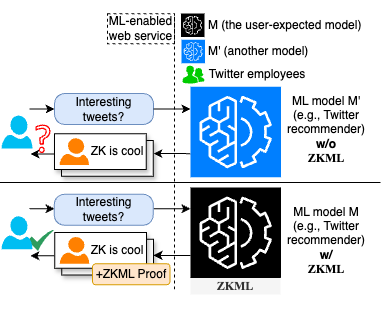 ZKML: An Optimizing System for ML Inference in Zero-Knowledge ProofsBing-Jyue Chen, Suppakit Waiwitlikhit, Ion Stoica, and 1 more authorIn Proceedings of the Nineteenth European Conference on Computer Systems (EuroSys) Apr 2024
ZKML: An Optimizing System for ML Inference in Zero-Knowledge ProofsBing-Jyue Chen, Suppakit Waiwitlikhit, Ion Stoica, and 1 more authorIn Proceedings of the Nineteenth European Conference on Computer Systems (EuroSys) Apr 2024Machine learning (ML) is increasingly used behind closed systems and APIs to make important decisions. For example, social media uses ML-based recommendation algorithms to decide what to show users, and millions of people pay to use ChatGPT for information every day. Because ML is deployed behind these closed systems, there are increasing calls for transparency, such as releasing model weights. However, these service providers have legitimate reasons not to release this information, including for privacy and trade secrets. To bridge this gap, recent work has proposed using zero-knowledge proofs (specifically a form called ZK-SNARKs) for certifying computation with private models but has only been applied to unrealistically small models. In this work, we present the first framework, ZKML, to produce ZK-SNARKs for realistic ML models, including state-of-the-art vision models, a distilled GPT-2, and the ML model powering Twitter’s recommendations. We accomplish this by designing an optimizing compiler from TensorFlow to circuits in the halo2 ZK-SNARK proving system. There are many equivalent ways to implement the same operations within ZK-SNARK circuits, and these design choices can affect performance by 24×. To efficiently compile ML models, ZKML contains two parts: gadgets (efficient constraints for low-level operations) and an optimizer to decide how to lay out the gadgets within a circuit. Combined, these optimizations enable proving on a wider range of models, faster proving, faster verification, and smaller proofs compared to prior work.
2022
-
 User Recommendation in Social Metaverse with VRBing-Jyue Chen, and De-Nian YangIn Proceedings of the 31st ACM International Conference on Information and Knowledge Management (CIKM) Oct 2022
User Recommendation in Social Metaverse with VRBing-Jyue Chen, and De-Nian YangIn Proceedings of the 31st ACM International Conference on Information and Knowledge Management (CIKM) Oct 2022Social metaverse with VR has been viewed as a paradigm shift for social media. However, most traditional VR social platforms ignore emerging characteristics in a metaverse, thereby failing to boost user satisfaction. In this paper, we explore a scenario of socializing in metaverse with VR, which brings major advantages over conven- tional social media: 1) leverage flexible display of users’ 360-degree viewports to satisfy individual user interests, 2) ensure the user feelings of co-existence, 3) prevent view obstruction to help users find friends in crowds, and 4) support socializing with digital twins. Therefore, we formulate the Co-presence, and Occlusion-aware Metaverse User Recommendation (COMUR) problem to recom- mend a set of rendered players for users in social metaverse with VR. We prove COMUR is an NP-hard optimization problem and design a dual-module deep graph learning framework (COMURNet) to recommend appropriate users for viewport display. Experimen- tal results on real social metaverse datasets and a user study with Occulus Quest 2 manifest that the proposed model outperforms baseline approaches by at least 36.7% of solution quality.
-
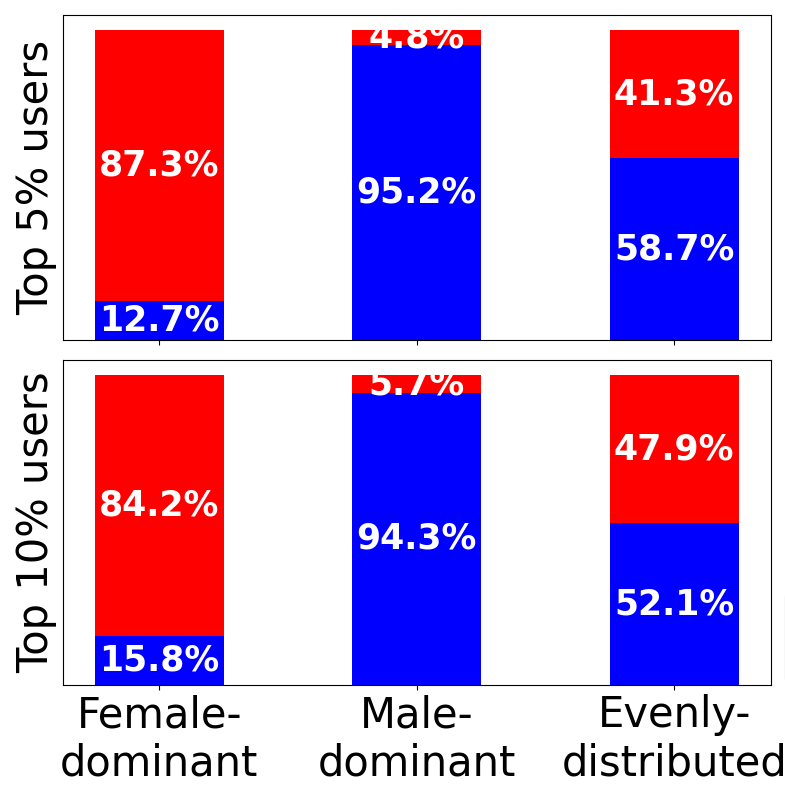 Targeted Influence with Community and Gender-Aware SeedingMaciej Styczen, Bing-Jyue Chen, Ya-Wen Teng, and 3 more authorsIn Proceedings of the 31st ACM International Conference on Information and Knowledge Management (CIKM) Oct 2022
Targeted Influence with Community and Gender-Aware SeedingMaciej Styczen, Bing-Jyue Chen, Ya-Wen Teng, and 3 more authorsIn Proceedings of the 31st ACM International Conference on Information and Knowledge Management (CIKM) Oct 2022When spreading information over social networks, seeding algorithms selecting users to start the dissemination play a crucial role. The majority of existing seeding algorithms focus solely on maximizing the total number of reached nodes, overlooking the issue of group fairness, in particular, gender imbalance. To tackle the challenge of maximizing information spread on certain target groups, e.g., females, we introduce the concept of the community and gender-aware potential of users. We first show that the network’s community structure is closely related to the gender distribution. Then, we propose an algorithm that leverages the information about community structure and its gender potential to iteratively modify a seed set such that the information spread on the target group meets the target ratio. Finally, we validate the algorithm by performing experiments on synthetic and real-world datasets. Our results show that the proposed seeding algorithm achieves not only the target ratio but also the highest information spread, compared to the state-of-the-art gender-aware seeding algorithm.
2021
-
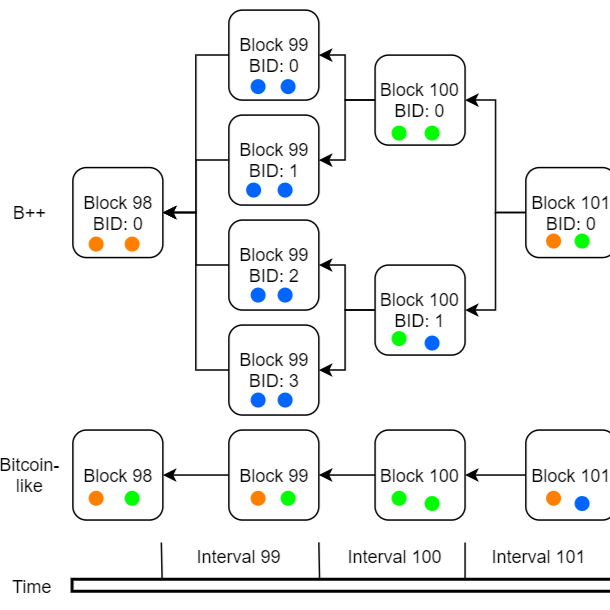 B++: A High-Throughput Proof-of-Work based Blockchain with Eventual ConsistencyBing-Jyue Chen, Ting-Han Jian, and Tsung-Nan LinIn ICC 2021 - IEEE International Conference on Communications Jun 2021
B++: A High-Throughput Proof-of-Work based Blockchain with Eventual ConsistencyBing-Jyue Chen, Ting-Han Jian, and Tsung-Nan LinIn ICC 2021 - IEEE International Conference on Communications Jun 2021Blockchain plays an important role in a variety of fields because it enables peers to cooperate with each other in a decentralized database. In Bitcoin-like protocols, each block is always mined by all miners, which implies a design philosophy that all transactions should be protected with the highest security. As a result, the throughput is bounded in these protocols. In real-world applications, the security requirement of transactions differs. Therefore, we present B++, a scalable blockchain structure, which breaks the limits of blockchain security so that B++ can distribute system resources efficiently to confirm transactions with different requirements. In our analysis, we show that B++ inherits eventual consistency in Bitcoin-like protocols. Moreover, our open-source simulation indicates that the throughput of B++ can be more than 100 times greater than that of baseline approaches; besides, the number of timeout transactions in B++ can decrease by up to 70% than that in a Bitcoin-like blockchain.
-
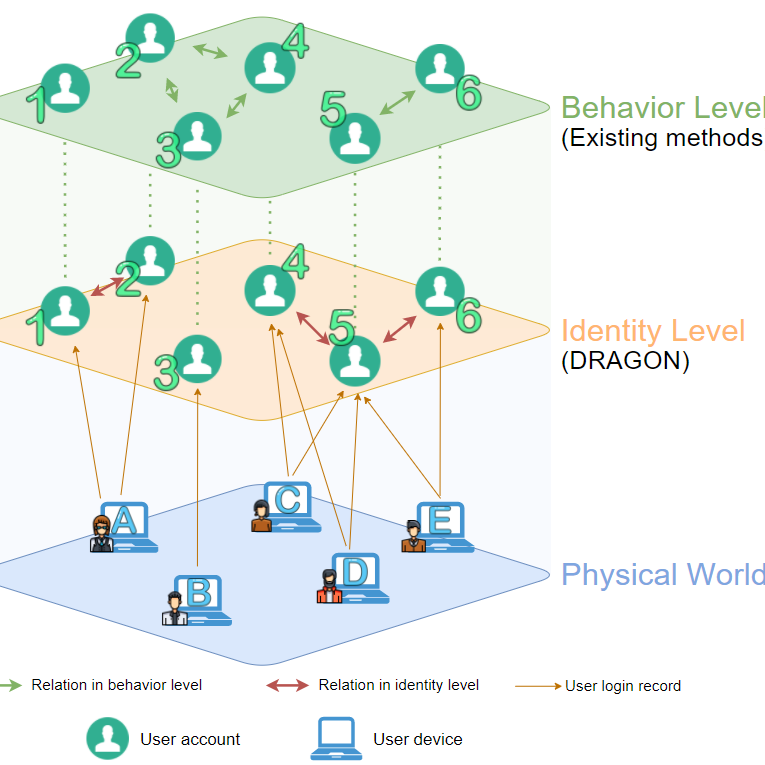 DRAGON: Detection of Related Account Groups for Online Services with Uncertain GraphsBing-Jyue Chen, Wun-Cing Liou, Hsing-Yu Shih, and 1 more authorIn 2021 IEEE Global Communications Conference (GLOBECOM) Dec 2021
DRAGON: Detection of Related Account Groups for Online Services with Uncertain GraphsBing-Jyue Chen, Wun-Cing Liou, Hsing-Yu Shih, and 1 more authorIn 2021 IEEE Global Communications Conference (GLOBECOM) Dec 2021With the rising influence of current online services, it is important for service providers to discover related accounts because it helps detect suspicious account groups. Existing research on this topic mostly focuses on a variety of account behaviors. Little attention has been paid to relations among account identity, which unveils the relationship between accounts and real-world people. In this paper, we propose DRAGON for modeling an account identity network and detecting suspicious account groups among this network. To this end, identifiers for tracking physical devices are collected and uncertain graph is used for modeling uncertainty in the network. Within this network, a strategy for detecting suspicious account groups is also investigated in DRAGON. We evaluate DRAGON using a real-world dataset. The results indicate that DRAGON achieves a 280% improvement in precision and 150% improvement in recall compared to a binary classifier.